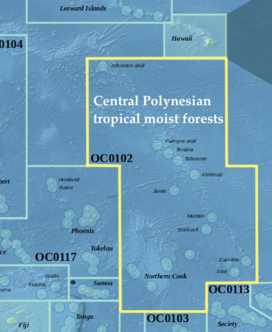The Central Polynesian tropical moist forests is a tropical and subtropical moist broadleaf forests ecoregion in Polynesia. It includes the northern group of the Cook Islands, the Line Islands in Kiribati, and Johnston Atoll, Jarvis Island, Palmyra Atoll, and Kingman Reef which are possessions of the United States.
| Central Polynesian tropical moist forests | |
|---|---|
 black noddies (Anous minutus) and fairy terns (Gygis alba) nesting in the crowns of pisonia trees (Pisonia grandis) on Pig Islet, Caroline Atoll, Kiribati. | |
 Location of the Central Polynesian tropical moist forests | |
| Ecology | |
| Realm | Oceanian |
| Biome | tropical and subtropical moist broadleaf forests |
| Geography | |
| Area | 616 km2 (238 sq mi) |
| Countries | |
| Conservation | |
| Conservation status | Critical/endangered[1] |
| Global 200 | South Pacific Islands forests |
| Protected | 83%[2] |
Geography
editAll the islands in the ecoregion are atolls, low islands of coral sand surrounding a central lagoon. There are eight inhabited and nine uninhabited atolls.
The islands of the ecoregion are aligned from north-northwest to south-southeast for 3,400 kilometres (2,100 mi), crossing the equator. The northernmost, Johnston Atoll, is at 16°44′N latitude and 169°31′W longitude. The southernmost is Suwarrow at 13°16′S latitude and 163° 7′W longitude.
Teraina, Tabuaeran, Kiritimati, Malden, Starbuck, Vostok, Caroline, and Flint are part of Kiribati. Kingman Reef, Palmyra Atoll, and Jarvis Island are territories of the United States. Kiritimati is the largest island in the 388 square kilometres.
Johnston Atoll lies northwest of the Line Islands and southwest of the Hawaiian Islands.
The Northern Cook Islands include the atolls of Pukapuka, Rakahanga, Manihiki, Penrhyn, and Suwarrow. The Southern Cook Islands are in the separate Cook Islands tropical moist forests ecoregion.
Climate
editThe climate of the islands is tropical. Temperature is warm year-round, with little seasonal variation. The southern and northern islands are within the trade wind belt, and regularly receive 1,500 and 3,000 mm of annual rainfall. The islands within 5° latitude of the equator receive less than 1000 mm annually, with periodic droughts.[1]
Flora
editThe native vegetation on the more humid islands is tropical atoll forest. The characteristic species are common to coastal Indo-Pacific areas, and include the trees Pisonia grandis, Calophyllum inophyllum, Heliotropium foertherianum, Pandanus tectorius, Cordia subcordata, and Guettarda speciosa, and the shrubs Morinda citrifolia, Scaevola taccada, Suriana maritima, and Pemphis acidula.[1]
The driest and lowest islands are covered with low plants, including the grass Lepturus repens and the creepers Tribulus cistoides or Portulaca lutea, with areas of Heliotropium foertherianum, Pemphis acidula, and Scaevola taccada scrub.[1]
Fauna
editThe islands' vertebrate fauna is principally seabirds, which form large colonies on some islands. There are no native non-marine mammals or amphibians.
The sole passerine bird is the endemic bokikokiko (Acrocephalus aequinoctialis), a reed warbler found on Teraina, Tabuaeran, and Kiritimati. Kuhl's lorikeet (Vini kuhlii) is an endangered parrot found on Kiritimati and Teraina and on Rimatara in the Tubuai Islands to the southeast. Its range once included the Cook Islands.[1]
Protected areas
editA 2017 assessment found that 83% of the ecoregion is in protected areas.[2] protected areas include:
- Kiritimati wildlife refuge
- Suwarrow atoll
- Pacific Islands Heritage Marine National Monument protects Kingman Reef, Johnson Atoll, Jarvis Island, and Palmyra Atoll.
References
edit- ^ a b c d e "Central Polynesian tropical moist forests". Terrestrial Ecoregions. World Wildlife Fund.
- ^ a b Dinerstein, Eric; Olson, David; et al. (June 2017). "An Ecoregion-Based Approach to Protecting Half the Terrestrial Realm". BioScience. 67 (6): 534–545. doi:10.1093/biosci/bix014. PMC 5451287. PMID 28608869.
{{cite journal}}: CS1 maint: date and year (link) Supplemental material 2 table S1b.
External links
edit- "Central Polynesian tropical moist forests". Terrestrial Ecoregions. World Wildlife Fund.
- Central Polynesian tropical moist forests (DOPA)
- Central Polynesian tropical moist forests (Encyclopedia of Earth)